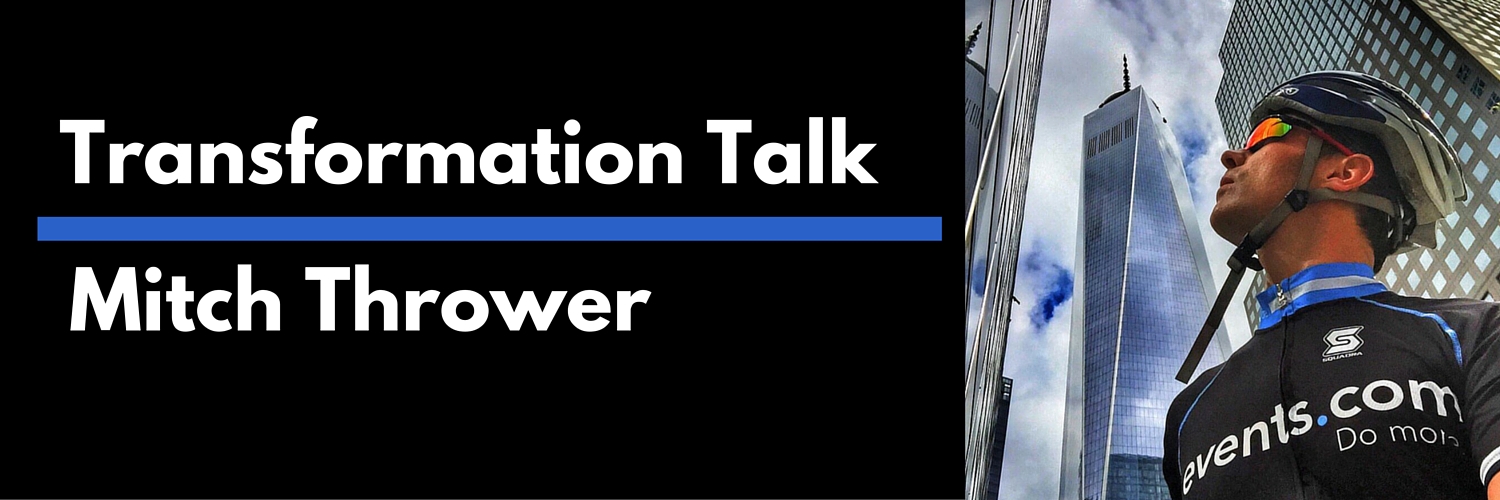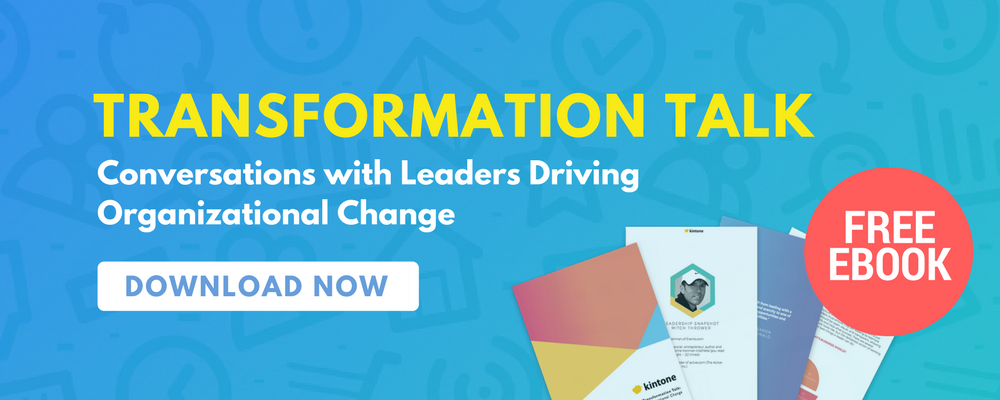Transformation Talk is an ongoing series featuring leaders who have led impactful change initiatives at organizations of all shapes and sizes.
We had the opportunity to speak with Mitch Thrower, who's not only the Founder and Chairman of Events.com, but also a financier, entrepreneur, author and a 22-time Ironman triathlete (you read that right -- 22 times!)
How did you get your start in business transformation?
In 1990 I started a company called The College Connection, Inc. The initial concept was to create a marketing agency to help businesses market to college students. A few clients signed up – Dominos, a ticketing company and several others. One of the products we were working on was called “The Passport,” which was a printed guidebook for college students traveling in Europe. It gained significant traction when thousands of study abroad offices across the country agreed to distribute it to tens of thousands of students. Working with a close friend and business partner, Todd Adelman, we signed advertising contracts to market AT&T phone services, American Express cards, and travel merchandise. We also signed a pivotal commission contract with FrenchRail to sell Eurail passes to college students.
 We thought we were a publishing and marketing company, but just a few months after we distributed the booklets, 95% of our revenues had come from the commissions on Eurail pass sales. Suddenly, we were selling millions of dollars’ worth of travel tickets. Our team refocused the business to become a travel company and ultimately creating an online ordering system for Eurail passes in the nascent days of the web. We ultimately sold the company under its new name, The Rail Connection, to a travel guru named Mike Fuller at Student Advantage.
We thought we were a publishing and marketing company, but just a few months after we distributed the booklets, 95% of our revenues had come from the commissions on Eurail pass sales. Suddenly, we were selling millions of dollars’ worth of travel tickets. Our team refocused the business to become a travel company and ultimately creating an online ordering system for Eurail passes in the nascent days of the web. We ultimately sold the company under its new name, The Rail Connection, to a travel guru named Mike Fuller at Student Advantage.
In hindsight, we started as a marketing company, then became a publishing company then ultimately became a travel company. As we pivoted in the direction of revenue, we changed course quickly. We shelved many other concepts in development including The “Ameripass,” a guidebook for students traveling to the US, and a national news network for college students.
In the early days of a start-up, it’s easy for people to become obsessed with creativity, and forget about the most important formula: Value is generated when someone pays for a product or service, and shareholder value is created when a company makes more than it spends. Organizations need to be nimble and follow the North Star (profitable revenue) to optimize this formula.
What are some of your greatest business transformation successes? Failures?
I co-founded an investment company to orchestrate a leveraged buyout of Triathlete Magazine. When we purchased the magazine, the owner required us to also purchase a cycling magazine that had once been a great title, but had lost its momentum as a result of a former employee’s departure to start a competitive cycling magazine. So based on a visionary advisor’s claim that adventure and obstacle racing would become the next great sport (this was in 1997, more than a decade before Spartan and other mud and obstacle races existed), we transformed Winning Magazine into Adventure Racing magazine.
At the time we put it on the newsstands, there were only a handful of adventure or obstacle racers globally. Ironically, the magazine titled Winning lost money with each issue after its re-launch and it was draining resources we needed to grow our core asset, Triathlete Magazine. We hired a professional publisher and focused all our efforts into growing Triathlete Magazine and into completing the leveraged buyout. It took about a decade to complete the buyout, whereupon we sold Triathlete Magazine to Competitor Group, keeping some equity in the Competitor Group, which a private equity firm had backed. Ultimately, Competitor Group was sold to Calera Capital for close to $250 million.
What I learned from buying two sister publications, Triathlete and Winning, was that re-launching Winning was a distraction. The most powerful force in the entrepreneurial universe is focus. Your time, capital and attention are limited resources. Transforming our operation and then focusing all resources on completing the buyout of Triathlete, as well as growing the brand, paid off.
What top three skills/attributes should a good change leader have?
- Adaptability – Change leaders need to be able to adapt and to lead by example. As a leader, your emotions and reactions to change are highly contagious.
- Communication Skills – The greatest negative force in a changing environment is the unknown. People fear what they don’t know. Leaders who manage through change possess the skills and desire to communicate openly with confidence and clarity.
- Strong Integrity / Trustworthiness – Organizational and business change is often chaotic. When confronted with tumultuous change, people will follow a leader whom they trust and who has confidence and, most importantly, who is a paragon of integrity. Leaders who do not lead by truth and integrity will invariably build a blame-others-for-the bad-and-steal-credit-for-the-good culture, because everyone will be looking over their shoulder. Find the good guys, then work with them.
What's your advice to people starting out in their careers who have leadership aspirations?
Leadership is an endurance sport. People, companies and markets all change. True leaders do not resist change—they stand ready for it. In the sport of triathlon, we have a transition between swimming and biking and between biking and running. In business, focus on getting the transitions right. A good leader knows how and when to change things.
I’ve learned through investing in, founding and co-founding different companies over the years that some leaders and team members that we hired, who initially seemed to be super heroes, turned out to be villains. People change when money is involved and value is created. As companies grow, and things change, people often forget the contributions of others and overestimate their own contributions at all levels of an organization. Good leaders elevate others and demonstrate appreciation for all contributions as a company grows through changes.
ALSO READ:
- Jill Dyché, Author of ‘New IT,’ Talks Cultivating Change, IT Education & Good Wine
- How Radical Self-Awareness Won Over Employees And Transformed An Organization
People also show their true colors when times get tough – and things invariably will get tough at some point—so choose who you work with wisely and watch them closely when things get tough. Before you start working with people, do background checks, do personality tests and hire people for trial periods before you bring them on full time. Find people who will support you as you grow your organization through an ever changing landscape.
What are some good self-care tips for change leaders, especially during tumultuous times in their career?
People associate who they are with what they do; they therefore put a great deal of emotional energy into their roles and ranks at work. While some people like to play “office,” others like to work hard. Fill your company with the hard workers to whom you can delegate with confidence. Find and employ people who will bring you solutions and who are eager to do the heavy lifting to implement them. Working for a company carries with it a set of almost “parental expectations” of employers. After all, employers pay health insurance and a bi-weekly “allowance” and this can lead to a very emotional sense of both obligation and dependency.
You will likely experience the proliferation of expectations put upon you—expectations from team members, shareholders and from customers. Everyone will want you, the leader, to solve their problems. There are a few things you can do to help manage those leadership expectations through your career:
- Take care of yourself. Book some time on your overbooked calendar that is your time and your time only. Set aside time for a run, to read, or just decompress in a coffee shop between home and work.
- Develop friendships with people you don’t work with. Leaders have a tendency to spend so much time at work that their social circles outside of work suffer, or don’t exist at all. Expand beyond your work circle, which will expand your thought aperture.
- Keep yourself fit at work. You’re going to spend a great deal of time at work. Take deep breaths while working and limit unnecessary meetings. Do push-ups and stomach exercises at work. Get a standing desk to decompress your spine, or even better, a bike and a standing bike desk.
- Take a step back and put things in perspective. You are standing on the crusty outer shell of a hunk of iron with a gooey flaming middle, flying around a flaming ball at 87,000 mph, in a solar system that is flying around the Milky Way Galaxy at 515,000 miles per hour in a galaxy that is hurtling through the universe at 2,200,000 miles per hour. Why get stressed because a human ant just quit your human ant hill, or because you need to change how you’re building that hill? There are plenty of ants. Remind yourself that life is much more than work and that change is an essential ingredient - whether you are in a triathlon transition or pivoting your company.
What are some of the biggest barriers to change in an organization?
Directional Alignment: Make a list of the people in your organization that you know need to be rowing in the same direction for your ship to get to its destination, then bring those people together. Make sure you invest quality time with the people you need to align with.
Make sure there are no hidden agendas and openly address issues and action steps. Hidden agendas are one of the greatest time wasters in many companies. The best way to eliminate hidden agendas when you detect them is to ask people openly “What are you trying to achieve?”
Surround yourself with the people who are honest with you, send the rest on their way.
Limited Time: With a flood of emails, texts, LinkedIn messages, Facebook messages, Skype chats and meeting requests, people at work often feel overwhelmed. There are often dramatic and unnecessary misunderstandings between people because important communication gets lost among the proliferation of messages. People know change will take time, and more effort, thus they shy away from it.
The “big picture” may not mean as much to people as the “immediate impact on them” does - which is why it’s important to communicate how changes will benefit them and the company, including the “why” behind the change. If people see change without the why, or they disagree with the “why” then they will challenge the leaders in subtle or open ways. It is very important to communicate the how and why.
Bringing Digital Change: We are very fortunate to live in a time where cloud-based no-code solutions exist to foster transparency so people at all levels of an organization can monitor the progression of projects and initiatives in real time. As a leader, you will need charts, calendars and documentation. It’s also important, with the state of overwhelm that most technology executives live in – to make sure nothing important falls through the cracks.
As a leader, you should avoid the time suck of micromanagement and empower your workforce to find information they need, collaborate and get feedback across the organization in one centralized platform.
About Mitch
He is the Founder and Chairman of Events.com, an innovative cloud-based Event Management Platform provider that provides a state of the art mobile-first SaaS application that enables the full event life-cycle, connecting event organizers and event goers.
Thrower Co-Founded of active.com (The Active Network, Inc.). He also launched ActiveEurope.com (Active Europe Network) as Co-Founder and CEO. Active went public before selling to Vista for $1.05 billion.
Thrower was the President and Chief Operating Officer of Triathlete Magazine, the world's largest triathlon magazine where he also served as Chairman. He has served as the Chief Interactive Officer, Strategist & Senior Correspondent for the Competitor Group (CGI), the active lifestyle industry's leading media and event entertainment company.
About the Author
Nicole is Director of Marketing at Kintone, with 10+ years experience in content strategy, campaign management, lead acquisition and building positive work cultures of empowered, purpose-driven team members. She spent seven years as a journalist, previously serving as a CBS San Francisco digital producer, NPR contributor, Patagon Journal deputy editor and reporter for several publications, including the Chicago Tribune. She's passionate about the tech for good space, social entrepreneurship and women leadership. On the weekends, you’ll likely find her putting her Master Gardener skills to use in at community gardens in Oakland.











